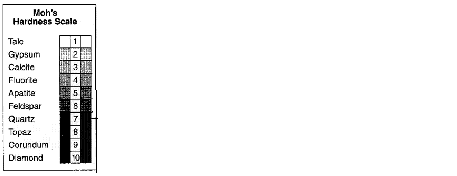| A | B |
|---|
| description of a mineral that breaks with smooth edges, definite lines | cleavage |
| description of a mineral's ability to be to scratch a mineral or be scratched by another mineral | hardness |
produces a colored powder line when a mineral is rubbed on a rough surface,  | streak |
| this mineral permits fizzing when hydrochloric acid (HCl) is added to its surface | chemical property of calcite |
| luster - metallic and non-metallic | the way in which a mineral reflects light |
definite chemical composition,  | each mineral is made of certain chemicals |
| Quartz | the most abundant mineral in the earth |
| carbonates | the second largest mineral family, contains Carbon (C) |
| Name this mineral which attracts certain metals | the special property of magnetite |
| silicates | largest mineral family, contains silicon (Si) and oxygen (O) |
| ore | general name for rocks containing metallic or nonmetallic minerals that can be mined for a profit |
| limestone | name of rock formed from calcite, fizzes when HCl is applied |
| description of mineral break with jagged edges | fracture |
VA sand is made of this mineral,  | Quartz |
| Talc | name of mineral that can be scratched by all other minerals,  |
Using a penny to test hardness of mineral,  | how to test hardness of a mineral with tools you have on hand |
| name of mineral with metallic luster called "Fools Gold" | pyrite |